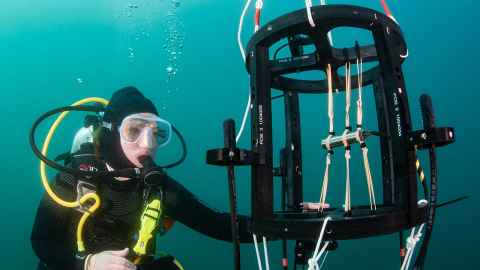Sound pollution from small boats interferes with fish hearing
24 May 2023
Sound pollution from small boats can add to stressors on fish, Hauraki Gulf research shows.

Sound pollution from small boats can interfere with the hearing of fish in shallow coastal waters, threatening to disrupt routines necessary for survival, according to University of Auckland research in the Hauraki Gulf.
Underwater microphones recorded the sound of a small boat with an outboard motor travelling in the Leigh marine reserve north of Auckland.
Modelling the effects, the scientists found the “listening space” of bigeye and triplefin fishes was reduced by 30 percent or more when the boat came within 24m. In contrast, the effect on two crustaceans, a type of crab and a type of shrimp, was minimal.
The results demonstrate the need to monitor and mitigate small boat sound worldwide, given that recreational boats in shallow coastal waters are highly common around the world, according to PhD student Louise Wilson and Associate Professor Craig Radford.
Their study was published in the journal Scientific Reports.
Anthropogenic sound can interfere with ecologically important cues for fish. Examples are reef sound, used by larval fishes and invertebrates to navigate towards coastal settlement habitats; sounds which fish make as part of seeking mates and reproducing; and prey listening out for the sounds of predators.

The study looked at four species common in the Hauraki Gulf:
- Bigeye (Pemphersis adspersa), a nocturnal fish which produces low-frequency ‘pop’ sounds to maintain contact with fellow bigeyes
- Common triplefin (Forsterygion lapillum), a reef species with larvae which use reef sound as a directional cue
- New Zealand paddle crab (Ovalipes catharus), which produces three sound types (‘zip’, ‘bass’, and ‘rasp’) associated with breeding and feeding
- Snapping shrimp (Alpheus richardsoni), which make a high-frequency sound dominant in temperate and tropical marine soundscapes, serving functions including territory defence and mate selection
Underwater sound is conveyed by both particle motion and pressure. In this case, the scientists used a sophisticated sensor and hydrophones (underwater microphones) to measure particle motion, the part of the sound field that fish detect.
For both bigeye and triplefin, the peak reduction in listening space was when a boat travelled at high speed very nearby at night: 93 percent for bigeye, and 66 percent for triple-fin.
The toll of anthropogenic sound on sea creatures is an expanding field of study, analogous to research into the understudied effects of light pollution on birds. Previous research in the Hauraki Gulf by the University showed sound from cargo and container ships and tankers reducing the communication space of species, including Bryde’s whales.
Sound pollution from small boats is a lot more variable than for ships and it's not necessarily the case that a slower boat is quieter or has less of an impact on fishes.
“Anthropogenic stressors, such as plastics and fishing, are putting coastal habitats under immense pressure,” the scientists wrote in their article. “However, sound pollution from small boats has received little attention…”
“Sound pollution from small boats in coastal habitats is quite different to what we see from large ships in the open ocean,” says Wilson. “Large ships are all designed very similarly, they generally follow set routes, and when they slow down, they are quieter, but this isn't necessarily the case for small boats which are much more variable in design, and can be handled or driven in many different ways.”
This means that small-boat sound is a lot more variable and it is not necessarily the case that a slower boat is quieter or has less of an impact on fishes.
“This needs to be taken into consideration if sound pollution in coastal habitats is to be managed and mitigated,” says Wilson.
For bigeyes and triplefins, the effects of noise impeding hearing and communication are likely to vary by life stage. The planktonic larvae of triplefins use reef sound to direct their nocturnal swimming towards settlement habitats, for instance, while adult triple-fins are bottom-dwellers, highly territorial and sedentary.
Reduced ability of these species to perceive acoustic cues during their lives could affect their fitness and survival, ”possibly leading to population and ecosystem scale effects,” the scientists write.
The world’s oceans are getting ever noisier from shipping, fishing, recreational boating, dredging, geophysical surveying, oil drilling, and sonar. The loudest sounds include seismic air guns blasting pressurized air to map the ocean floor for oil and gas exploration and geological research. Now, deep sea mining threatens to add to the cacophony.
The experiments were conducted in 2021, with the sensor and hydrophones deployed seven to eight metres below the surface. The boat was a 5.8m aluminium rigid-hulled inflatable with a 150-horsepower four stroke outboard.
Co-authors of the study were Waipapa Taumata Rau, University of Auckland’s Professor Rochelle Constantine, Matthew K. Pine of the University of Victoria in Canada and Adrian Farcas of the Centre for Environment, Fisheries & Aquaculture Science in the UK.
Media contact
Paul Panckhurst | media adviser
M: 022 032 8475
E: paul.panckhurst@auckland.ac.nz